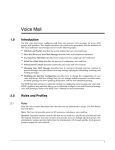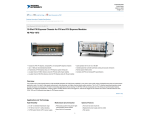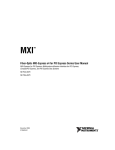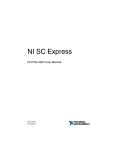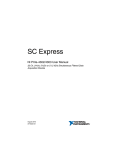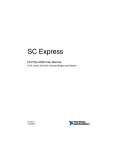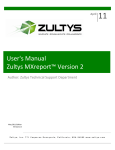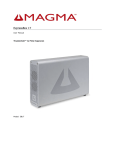Download PXI ExpressTM NI PXIe-1073 User Manual
Transcript
PXI Express NI PXIe-1073 User Manual NI PXIe-1073 User Manual February 2011 372768B-01 TM Support Worldwide Technical Support and Product Information ni.com Worldwide Offices Visit ni.com/niglobal to access the branch office Web sites, which provide up-to-date contact information, support phone numbers, email addresses, and current events. National Instruments Corporate Headquarters 11500 North Mopac Expressway Austin, Texas 78759-3504 USA Tel: 512 683 0100 For further support information, refer to the Technical Support and Professional Services appendix. To comment on National Instruments documentation, refer to the National Instruments Web site at ni.com/info and enter the Info Code feedback. © 2009–2011 National Instruments Corporation. All rights reserved. Important Information Warranty The PXIe-1073 is warranted against defects in materials and workmanship for a period of one year from the date of shipment, as evidenced by receipts or other documentation. National Instruments will, at its option, repair or replace equipment that proves to be defective during the warranty period. This warranty includes parts and labor. The media on which you receive National Instruments software are warranted not to fail to execute programming instructions, due to defects in materials and workmanship, for a period of 90 days from date of shipment, as evidenced by receipts or other documentation. National Instruments will, at its option, repair or replace software media that do not execute programming instructions if National Instruments receives notice of such defects during the warranty period. National Instruments does not warrant that the operation of the software shall be uninterrupted or error free. A Return Material Authorization (RMA) number must be obtained from the factory and clearly marked on the outside of the package before any equipment will be accepted for warranty work. National Instruments will pay the shipping costs of returning to the owner parts which are covered by warranty. National Instruments believes that the information in this document is accurate. The document has been carefully reviewed for technical accuracy. In the event that technical or typographical errors exist, National Instruments reserves the right to make changes to subsequent editions of this document without prior notice to holders of this edition. The reader should consult National Instruments if errors are suspected. In no event shall National Instruments be liable for any damages arising out of or related to this document or the information contained in it. EXCEPT AS SPECIFIED HEREIN, NATIONAL INSTRUMENTS MAKES NO WARRANTIES, EXPRESS OR IMPLIED, AND SPECIFICALLY DISCLAIMS ANY WARRANTY OF MERCHANTABILITY OR FITNESS FOR A PARTICULAR PURPOSE. CUSTOMER’S RIGHT TO RECOVER DAMAGES CAUSED BY FAULT OR NEGLIGENCE ON THE PART OF NATIONAL INSTRUMENTS SHALL BE LIMITED TO THE AMOUNT THERETOFORE PAID BY THE CUSTOMER. NATIONAL INSTRUMENTS WILL NOT BE LIABLE FOR DAMAGES RESULTING FROM LOSS OF DATA, PROFITS, USE OF PRODUCTS, OR INCIDENTAL OR CONSEQUENTIAL DAMAGES, EVEN IF ADVISED OF THE POSSIBILITY THEREOF. This limitation of the liability of National Instruments will apply regardless of the form of action, whether in contract or tort, including negligence. Any action against National Instruments must be brought within one year after the cause of action accrues. National Instruments shall not be liable for any delay in performance due to causes beyond its reasonable control. The warranty provided herein does not cover damages, defects, malfunctions, or service failures caused by owner’s failure to follow the National Instruments installation, operation, or maintenance instructions; owner’s modification of the product; owner’s abuse, misuse, or negligent acts; and power failure or surges, fire, flood, accident, actions of third parties, or other events outside reasonable control. Copyright Under the copyright laws, this publication may not be reproduced or transmitted in any form, electronic or mechanical, including photocopying, recording, storing in an information retrieval system, or translating, in whole or in part, without the prior written consent of National Instruments Corporation. National Instruments respects the intellectual property of others, and we ask our users to do the same. NI software is protected by copyright and other intellectual property laws. Where NI software may be used to reproduce software or other materials belonging to others, you may use NI software only to reproduce materials that you may reproduce in accordance with the terms of any applicable license or other legal restriction. Trademarks LabVIEW, National Instruments, NI, ni.com, the National Instruments corporate logo, and the Eagle logo are trademarks of National Instruments Corporation. Refer to the Trademark Information at ni.com/trademarks for other National Instruments trademarks. Other product and company names mentioned herein are trademarks or trade names of their respective companies. Members of the National Instruments Alliance Partner Program are business entities independent from National Instruments and have no agency, partnership, or joint-venture relationship with National Instruments. Patents For patents covering National Instruments products/technology, refer to the appropriate location: Help»Patents in your software, the patents.txt file on your media, or the National Instruments Patent Notice at ni.com/patents. WARNING REGARDING USE OF NATIONAL INSTRUMENTS PRODUCTS (1) NATIONAL INSTRUMENTS PRODUCTS ARE NOT DESIGNED WITH COMPONENTS AND TESTING FOR A LEVEL OF RELIABILITY SUITABLE FOR USE IN OR IN CONNECTION WITH SURGICAL IMPLANTS OR AS CRITICAL COMPONENTS IN ANY LIFE SUPPORT SYSTEMS WHOSE FAILURE TO PERFORM CAN REASONABLY BE EXPECTED TO CAUSE SIGNIFICANT INJURY TO A HUMAN. (2) IN ANY APPLICATION, INCLUDING THE ABOVE, RELIABILITY OF OPERATION OF THE SOFTWARE PRODUCTS CAN BE IMPAIRED BY ADVERSE FACTORS, INCLUDING BUT NOT LIMITED TO FLUCTUATIONS IN ELECTRICAL POWER SUPPLY, COMPUTER HARDWARE MALFUNCTIONS, COMPUTER OPERATING SYSTEM SOFTWARE FITNESS, FITNESS OF COMPILERS AND DEVELOPMENT SOFTWARE USED TO DEVELOP AN APPLICATION, INSTALLATION ERRORS, SOFTWARE AND HARDWARE COMPATIBILITY PROBLEMS, MALFUNCTIONS OR FAILURES OF ELECTRONIC MONITORING OR CONTROL DEVICES, TRANSIENT FAILURES OF ELECTRONIC SYSTEMS (HARDWARE AND/OR SOFTWARE), UNANTICIPATED USES OR MISUSES, OR ERRORS ON THE PART OF THE USER OR APPLICATIONS DESIGNER (ADVERSE FACTORS SUCH AS THESE ARE HEREAFTER COLLECTIVELY TERMED “SYSTEM FAILURES”). ANY APPLICATION WHERE A SYSTEM FAILURE WOULD CREATE A RISK OF HARM TO PROPERTY OR PERSONS (INCLUDING THE RISK OF BODILY INJURY AND DEATH) SHOULD NOT BE RELIANT SOLELY UPON ONE FORM OF ELECTRONIC SYSTEM DUE TO THE RISK OF SYSTEM FAILURE. TO AVOID DAMAGE, INJURY, OR DEATH, THE USER OR APPLICATION DESIGNER MUST TAKE REASONABLY PRUDENT STEPS TO PROTECT AGAINST SYSTEM FAILURES, INCLUDING BUT NOT LIMITED TO BACK-UP OR SHUT DOWN MECHANISMS. BECAUSE EACH END-USER SYSTEM IS CUSTOMIZED AND DIFFERS FROM NATIONAL INSTRUMENTS' TESTING PLATFORMS AND BECAUSE A USER OR APPLICATION DESIGNER MAY USE NATIONAL INSTRUMENTS PRODUCTS IN COMBINATION WITH OTHER PRODUCTS IN A MANNER NOT EVALUATED OR CONTEMPLATED BY NATIONAL INSTRUMENTS, THE USER OR APPLICATION DESIGNER IS ULTIMATELY RESPONSIBLE FOR VERIFYING AND VALIDATING THE SUITABILITY OF NATIONAL INSTRUMENTS PRODUCTS WHENEVER NATIONAL INSTRUMENTS PRODUCTS ARE INCORPORATED IN A SYSTEM OR APPLICATION, INCLUDING, WITHOUT LIMITATION, THE APPROPRIATE DESIGN, PROCESS AND SAFETY LEVEL OF SUCH SYSTEM OR APPLICATION. Compliance Electromagnetic Compatibility Information This hardware has been tested and found to comply with the applicable regulatory requirements and limits for electromagnetic compatibility (EMC) as indicated in the hardware’s Declaration of Conformity (DoC)1. These requirements and limits are designed to provide reasonable protection against harmful interference when the hardware is operated in the intended electromagnetic environment. In special cases, for example when either highly sensitive or noisy hardware is being used in close proximity, additional mitigation measures may have to be employed to minimize the potential for electromagnetic interference. While this hardware is compliant with the applicable regulatory EMC requirements, there is no guarantee that interference will not occur in a particular installation. To minimize the potential for the hardware to cause interference to radio and television reception or to experience unacceptable performance degradation, install and use this hardware in strict accordance with the instructions in the hardware documentation and the DoC1. If this hardware does cause interference with licensed radio communications services or other nearby electronics, which can be determined by turning the hardware off and on, you are encouraged to try to correct the interference by one or more of the following measures: • Reorient the antenna of the receiver (the device suffering interference). • Relocate the transmitter (the device generating interference) with respect to the receiver. • Plug the transmitter into a different outlet so that the transmitter and the receiver are on different branch circuits. Some hardware may require the use of a metal, shielded enclosure (windowless version) to meet the EMC requirements for special EMC environments such as, for marine use or in heavy industrial areas. Refer to the hardware’s user documentation and the DoC1 for product installation requirements. When the hardware is connected to a test object or to test leads, the system may become more sensitive to disturbances or may cause interference in the local electromagnetic environment. Operation of this hardware in a residential area is likely to cause harmful interference. Users are required to correct the interference at their own expense or cease operation of the hardware. Changes or modifications not expressly approved by National Instruments could void the user’s right to operate the hardware under the local regulatory rules. 1 The Declaration of Conformity (DoC) contains important EMC compliance information and instructions for the user or installer. To obtain the DoC for this product, visit ni.com/certification, search by model number or product line, and click the appropriate link in the Certification column. Contents About This Manual Conventions ...................................................................................................................vii Related Documentation..................................................................................................viii Chapter 1 Getting Started Unpacking ......................................................................................................................1-1 What You Need to Get Started ......................................................................................1-1 Key Features ..................................................................................................................1-2 Chassis Description........................................................................................................1-3 Optional Equipment .......................................................................................................1-5 EMC Filler Panels ...........................................................................................1-5 Slot Blockers ...................................................................................................1-5 Rack Mount Kit ...............................................................................................1-6 Handle/Feet Kit ...............................................................................................1-6 NI PXIe-1073 Chassis Backplane Overview.................................................................1-6 Interoperability with CompactPCI ..................................................................1-6 MXI Interface ..................................................................................................1-7 Hybrid Peripheral Slots ...................................................................................1-8 PXI Express Peripheral Slots...........................................................................1-8 PXI Local Bus .................................................................................................1-8 PXI Trigger Bus ..............................................................................................1-9 System Reference Clock..................................................................................1-9 Chapter 2 Installation and Configuration Safety Information .........................................................................................................2-1 Chassis Cooling Considerations ....................................................................................2-2 Providing Adequate Clearance ........................................................................2-2 Chassis Ambient Temperature Definition .......................................................2-3 Setting Fan Speed ............................................................................................2-3 Installing Filler Panels.....................................................................................2-4 Installing Slot Blockers ...................................................................................2-4 Rack Mounting ..............................................................................................................2-4 Connecting Safety Ground.............................................................................................2-4 Connecting to Power Source..........................................................................................2-4 Getting Started With The System ..................................................................................2-5 Unpacking The MXI-Express Host Card.......................................................................2-5 © National Instruments Corporation v NI PXIe-1073 User Manual Contents Hardware Installation .................................................................................................... 2-6 Installing an NI ExpressCard Module............................................................. 2-6 Installing an NI PCI Express Host Card ......................................................... 2-7 Cabling ............................................................................................................ 2-9 Powering Up the MXI-Express System .......................................................... 2-10 Powering Down the MXI-Express System ..................................................... 2-10 Checking LEDs for Status............................................................................... 2-11 Functional Overview ..................................................................................................... 2-11 MXI-Express Cable Options ......................................................................................... 2-12 Installing Peripheral Modules........................................................................................ 2-12 PXI Express System Configuration with MAX ............................................................ 2-14 Basic PXI System Configuration .................................................................... 2-15 Trigger Configuration in MAX....................................................................... 2-16 Using System Configuration and Initialization Files .................................................... 2-17 Chapter 3 Maintenance Service Interval.............................................................................................................. 3-1 Preparation..................................................................................................................... 3-1 Cleaning......................................................................................................................... 3-1 Interior Cleaning ............................................................................................. 3-2 Exterior Cleaning ............................................................................................ 3-2 Appendix A Specifications Appendix B Pinouts Appendix C Technical Support and Professional Services Glossary Index NI PXIe-1073 User Manual vi ni.com About This Manual The NI PXIe-1073 User Manual contains information about installing, configuring, using, and maintaining the NI PXIe-1073 chassis. Conventions The following conventions are used in this manual: » The » symbol leads you through nested menu items and dialog box options to a final action. The sequence Options»Settings»General directs you to pull down the Options menu, select the Settings item, and select General from the last dialog box. This icon denotes a note, which alerts you to important information. This icon denotes a caution, which advises you of precautions to take to avoid injury, data loss, or a system crash. When this symbol is marked on the product, refer to the Read Me First: Safety and Electromagnetic Compatibility document, shipped with the product, for precautions to take. bold Bold text denotes items that you must select or click in the software, such as menu items and dialog box options. Bold text also denotes parameter names. italic Italic text denotes variables, emphasis, a cross-reference, or an introduction to a key concept. Italic text also denotes text that is a placeholder for a word or value that you must supply. monospace Text in this font denotes text or characters that you should enter from the keyboard, sections of code, programming examples, and syntax examples. This font is also used for the proper names of disk drives, paths, directories, programs, subprograms, subroutines, device names, functions, operations, variables, filenames, and extensions. © National Instruments Corporation vii NI PXIe-1073 User Manual About This Manual Related Documentation The following documents contain information that you might find helpful as you read this manual: NI PXIe-1073 User Manual • IEEE 1101.1-1991, IEEE Standard for Mechanical Core Specifications for Microcomputers Using IEC 603-2 Connectors • IEEE 1101.10, IEEE Standard for Additional Mechanical Specifications for Microcomputers Using IEEE 1101.1 Equipment Practice • PICMG EXP.0 R1.0 CompactPCI Express Specification, PCI Industrial Computers Manufacturers Group • PCI Express Base Specification, Revision 1.1, PCI Special Interest Group • PXI-5 PXI Express Hardware Specification, Revision 2.0, PXI Systems Alliance • CompactPCI PICMG 2.0 R3.0 Specification, PCI Industrial Computers Manufacturing Group • NI PXIe-1073 Rack Mount Installation Guide viii ni.com 1 Getting Started This chapter describes the key features of the NI PXIe-1073 chassis, and lists the kit contents and optional equipment you can order from National Instruments. Unpacking Carefully inspect the shipping container and the chassis for damage. Check for visible damage to the metal work. Check to make sure all handles, hardware, and switches are undamaged. Inspect the inner chassis for any possible damage, debris, or detached components. If damage appears to have been caused during shipment, file a claim with the carrier. Retain the packing material for possible inspection and/or reshipment. What You Need to Get Started The NI PXIe-1073 chassis kit contains the following items: ❑ NI PXIe-1073 chassis ❑ Filler panels ❑ AC power cable—refer to Table 1-1 for AC power cables ❑ NI PXIe-1073 User Manual ❑ Read Me First: Safety and Electromagnetic Compatibility ❑ Driver CD-ROM containing NI PXI chassis software ❑ Chassis number labels ❑ MXI-Express x1 cable ❑ MXI-Express x1 host controller card © National Instruments Corporation 1-1 NI PXIe-1073 User Manual Chapter 1 Getting Started Table 1-1. AC Power Cables Power Cable Reference Standards Standard 120 V, 15 A (USA) NEMA 5-15 (gray color) Switzerland 220 V SEV Australia 240 V AS C112 Universal Euro 230 V CEE (7), II, IV, VII IEC83 North America 240 V, 15 A NEMA 6-15 (gray color) United Kingdom 230 V BS 1363/IEC83 Japan 100 V, 15 A JIS C8303 (gray color) If you are missing any of the items listed in Table 1-1, or if you have the incorrect AC power cable, contact National Instruments. Key Features The NI PXIe-1073 combines a 5-slot PXI backplane with a structural design that has been optimized for maximum usability in a wide range of applications. The key features of the chassis include the following: NI PXIe-1073 User Manual • Accepts 3U PXI Express, CompactPCI Express, and hybrid slot compatible PXI-1/CompactPCI (PICMG EXP.0 R1.0) modules • 5 peripheral slots in a rugged, compact chassis with universal AC input, and automatic voltage/frequency ranging • Integrated MXI-Express controller • On/Standby momentary power switch on the front panel for easy access • AUTO/HIGH temperature-controlled fan speed based on air-intake temperature to minimize audible noise • Carrying handle for portability (Optional) • Rack mountable 1-2 ni.com Chapter 1 Getting Started Chassis Description Figure 1-1 and Figure 1-2 show the key features of the NI PXIe-1073 chassis front and rear panels. Figure 1-1 shows the front view of the NI PXIe-1073. Figure 1-2 shows the rear view of the NI PXIe-1073. Figure 1-3 shows the bottom of the chassis. NI PXIe-1073 7 1 2 3 5 6 1 2 3 4 Captive Screw PXI Filler Panel Rubber Foot Generic Peripheral Slots 5 6 7 4 Link LED Power Switch Power Supply Airflow Intake Vents Figure 1-1. Front View of the NI PXIe-1073 Chassis © National Instruments Corporation 1-3 NI PXIe-1073 User Manual Chapter 1 Getting Started 1 2 3 7 6 1 2 3 4 Rear Exhaust Vents AC Input Power Supply Fan Exhaust NI MXI-Express Chassis Controller Connector 4 5 5 6 7 Chassis Ground Screw Auto/High Fan Speed Selector Switch Rubber Foot Figure 1-2. Rear View of the NI PXIe-1073 Chassis NI PXIe-1073 User Manual 1-4 ni.com Chapter 1 1 1 2 3 2 Rubber Foot Power Switch 3 4 Getting Started 4 Fan Intake Cover Fan Intake Cover Screw Figure 1-3. Bottom View of the NI PXIe-1073 Chassis Optional Equipment Contact National Instruments to order the following options for the NI PXIe-1073 chassis. EMC Filler Panels Optional EMC filler panel kits are available from National Instruments. Slot Blockers Optional slot blocker kits are available from National Instruments for improved thermal performance when all slots are not used. © National Instruments Corporation 1-5 NI PXIe-1073 User Manual Chapter 1 Getting Started Rack Mount Kit A rack mount kit option is available for mounting the NI PXIe-1073 chassis into a 19 in. instrument cabinet. Refer to Figure A-3, NI PXIe-1073 Chassis Rack Mount Kit Components, for more information. Handle/Feet Kit An optional side handle and rubber feet kit is available from National Instruments to provide a handle for portability. NI PXIe-1073 Chassis Backplane Overview Interoperability with CompactPCI The design of the NI PXIe-1073 provides you the flexibility to use the following devices in a single PXI Express chassis: NI PXIe-1073 User Manual • PXI Express compatible products • CompactPCI Express compatible Type-2 peripheral products • PXI hybrid slot compatible peripheral products • Standard CompactPCI peripheral products 1-6 ni.com Chapter 1 Getting Started Refer to Figure 1-4 for an overview of the NI PXIe-1073 architecture. MXIe X1 (to host) x1 x1 x1 x1 x1 (Upstream) x1 x1 x1 x1 x1 PCIe Switch x1 x1 PCIe/PCI Bridge PCI Bus F1 E1 D1 C1 B1 A1 Z1 F1 E1 D1 C1 B1 A1 Z1 F1 E1 D1 C1 B1 A1 Z1 Figure 1-4. NI PXIe-1073 Backplane Architecture The chassis backplane has +5 V V(I/O). Refer to the CompactPCI PICMG 2.0 R 3.0 Specification for details regarding V(I/O). MXI Interface The NI PXIe-1073 chassis has a built-in x1 MXI-Express interface that can be accessed through the MXI-Express chassis controller connector on the back of the chassis, as shown in Figure 1-2. The MXIe interface can be cabled to a remote system with a host card using a x1 MXI-Express cable to provide control of the NI PXIe-1073 chassis. Note The NI PXIe-1073 chassis does not have a slot number 1 because it is replaced by the MXIe interface rear connector. © National Instruments Corporation 1-7 NI PXIe-1073 User Manual Chapter 1 Getting Started Hybrid Peripheral Slots The chassis provides three (3) hybrid peripheral slots (slot numbers 4–6) as defined in the PXI-5 PXI Express Hardware Specification. These hybrid peripheral slots can accept the following peripheral modules: • A PXI Express Peripheral with a x1 PCI Express link through the PCI Express switch to the upstream PC. • A CompactPCI Express Type-2 Peripheral with a x1 PCI Express link through a PCI Express switch to the upstream PC. • A hybrid-compatible PXI Peripheral module that has been modified by replacing the J2 connector with an XJ4 connector installed in the upper eight rows of J2. Refer to the PXI Express Specification for details. The PXI Peripheral communicates through the backplane’s 32-bit PCI bus. • A CompactPCI 32-bit peripheral on the backplane’s 32-bit PCI bus. The hybrid peripheral slots provide full PXI Express functionality and 32-bit PXI functionality except for PXI Local Bus. The hybrid peripheral slot only connects to PXI Local Bus 6 left and right. PXI Express Peripheral Slots There are two (2) PXI Express peripheral slots: slots 2 and 3. PXI Express peripheral slots can accept the following modules: • A PXI Express Peripheral with a x1 PCI Express link through the PCI Express switch to the upstream PC. • A CompactPCI Express Type-2 Peripheral with a x1 PCI Express link through a PCI Express switch to the upstream PC. PXI Local Bus The PXI backplane local bus is a daisy-chained bus that connects each peripheral slot with the adjacent peripheral slots to the left and right (refer to Figure 1-5). The backplane routes PXI Local Bus 6 between adjacent PXI slots. The left local bus 6 from slot 2 is not routed anywhere and the right local bus signal from slot 6 is not routed anywhere. Local bus signals may range from high-speed TTL signals to analog signals as high as 42 V. NI PXIe-1073 User Manual 1-8 ni.com Embedded MXI Controller Getting Started Local Bus Peripheral Slot [6] Local Bus Peripheral Slot [5] Local Bus Peripheral Slot [4] Local Bus Peripheral Slot [3] Peripheral Slot [2] Chapter 1 PCI Arbitration and Clock Signals Figure 1-5. Local Bus Routing PXI Trigger Bus All slots share eight PXI trigger lines. You can use these trigger lines in a variety of ways. For example, you can use triggers to synchronize the operation of several different PXI peripheral modules. Modules can pass triggers to one another, allowing precisely timed responses to asynchronous external events the system is monitoring or controlling. The PXI trigger lines allow you to send trigger signals to, and receive trigger signals from, every slot in the chassis. Static trigger routing (user-specified line assignments) can be configured through Measurement & Automation Explorer (MAX). Dynamic routing of triggers (automatic line assignments) is supported through certain National Instruments drivers like NI-DAQmx. System Reference Clock The NI PXIe-1073 provides a 10 MHz clock (PXI_CLK10) and 100 MHz clock (PXIe_CLK100) to each peripheral slot. The 100 MHz clock is a high speed LVPECL clock, while the 10 MHz clock is a TTL/CMOS clock. The backplane also provides a PXIe_SYNC100 signal which asserts a 10 ns pulse which is synchronous to PXIe_CLK100. An independent buffer (having a source impedance matched to the backplane and a skew of less than 250 ps between slots) drives PXI_CLK10 to each peripheral slot. You can use this common reference clock signal to synchronize multiple modules in a measurement or control system. © National Instruments Corporation 1-9 NI PXIe-1073 User Manual Chapter 1 Getting Started An independent buffer drives PXIe_CLK100 to each peripheral slot. These clocks are matched in skew to less than 100 ps. The differential pair must be terminated on the peripheral with LVPECL termination for the buffer to drive PXIe_CLK100 so that when there is no peripheral or a peripheral that does not connect to PXIe_CLK100, there is no clock being driven on the pair to that slot. Refer to Figure 1-6 for a termination example. CLK100 + + CLK100 – – 50 Ω 50 Ω 47 Ω 0.01 µF Figure 1-6. CLK100 Termination An independent buffer drives PXIe_SYNC100 to each peripheral slot. The differential pair must be terminated on the peripheral with LVPECL termination for the buffer to drive PXIe_SYNC100 so that when there is no peripheral or a peripheral that does not connect to PXIe_SYNC100, there is no SYNC100 signal being driven on the pair to that slot. Refer to Figure 1-6 for a termination example. PXI_CLK10, PXIE_CLK100, and PXIE_SYNC100 are driven to every peripheral slot and have the default timing relationship described in Figure 1-7. 0 1 2 3 4 5 6 7 8 9 0 1 2 3 4 5 6 7 8 9 0 1 2 3 4 5 6 7 8 9 PXIe_CLK100 PXI_CLK10 PXIe_SYNC100 Figure 1-7. System Reference Clock Default Behavior NI PXIe-1073 User Manual 1-10 ni.com Installation and Configuration 2 This chapter describes how to install, configure, and use the NI PXIe-1073 chassis. Before connecting the chassis to a power source, read this chapter and the Read Me First: Safety and Electromagnetic Compatibility document included with your chassis. Safety Information Caution Before undertaking any troubleshooting, maintenance, or exploratory procedure, carefully read the following caution notices. This equipment contains voltage hazardous to human life and safety, and is capable of inflicting personal injury. • Chassis Grounding—The chassis requires a connection from the premise wire safety ground to the chassis ground. The earth safety ground must be connected during use of this equipment to minimize shock hazards. Refer to the Connecting Safety Ground section for instructions on connecting safety ground. • Live Circuits—Operating personnel and service personnel must not remove protective covers when operating or servicing the chassis. Adjustments and service to internal components must be undertaken by qualified service technicians. During service of this product, the mains connector to the premise wiring must be disconnected. Dangerous voltages may be present under certain conditions; use extreme caution. • Explosive Atmosphere—Do not operate the chassis in conditions where flammable gases are present. Under such conditions, this equipment is unsafe and may ignite the gases or gas fumes. © National Instruments Corporation 2-1 NI PXIe-1073 User Manual Chapter 2 Installation and Configuration • Part Replacement—Only service this equipment with parts that are exact replacements, both electrically and mechanically. Contact National Instruments for replacement part information. Installation of parts with those that are not direct replacements may cause harm to personnel operating the chassis. Furthermore, damage or fire may occur if replacement parts are unsuitable. • Modification—Do not modify any part of the chassis from its original condition. Unsuitable modifications may result in safety hazards. Chassis Cooling Considerations The NI PXIe-1073 chassis is designed to operate on a bench or in an instrument rack. Determine how you want to use the chassis and follow the appropriate installation instructions. Providing Adequate Clearance Caution Failure to provide adequate clearances may result in thermal related failures in the chassis or modules. Apertures in the top, bottom, front, rear, and along the right side of the chassis facilitate power supply and module cooling. Air enters through a fan intake in the bottom of the chassis for module cooling. It then exits through the upper sections at the right side, back, and through the top, as shown in Figure 2-1. Air cooling the power supply enters the front of the chassis, which is shown in Figure 1-1, Front View of the NI PXIe-1073 Chassis, then exits through the rear of the chassis, which is shown in Figure 1-2, Rear View of the NI PXIe-1073 Chassis. Place the chassis on a bench top or in an instrument rack so that the fans (air intakes) and the air outlet apertures along the right side, the top, and the back of the chassis have adequate ventilation. Provide at least 44.5 mm (1.75 in.) clearance above, behind, and on the sides of the unit for adequate venting. High-power applications may require additional clearance. NI PXIe-1073 User Manual 2-2 ni.com Chapter 2 Installation and Configuration 1 2 1 Air Outlets 2 Air Intake Figure 2-1. NI PXIe-1073 Module Cooling Airflow Side View Chassis Ambient Temperature Definition The chassis fan control system uses intake air temperature as the input for controlling fan speeds when in Auto Fan Speed mode. Because of this, the chassis ambient temperature is defined as the temperature that exists just outside of the fan intake vent on the bottom of the chassis. Note that this temperature may be higher than ambient room temperature depending on the surrounding equipment and/or blockages present. It is the user’s responsibility to ensure that this ambient temperature does not exceed the rated ambient temperature as stated in Appendix A, Specifications. Setting Fan Speed The AUTO/HIGH fan-speed selector switch is on the rear panel of the NI PXIe-1073. Refer to Figure 1-2, Rear View of the NI PXIe-1073 Chassis, to locate the fan-speed selector switch. Select HIGH for maximum cooling performance (recommended) or AUTO for quieter operation. When set to AUTO, the fan speed is determined by chassis intake air temperature. © National Instruments Corporation 2-3 NI PXIe-1073 User Manual Chapter 2 Installation and Configuration Installing Filler Panels To improve module cooling performance, install filler panels (provided with the chassis) in unused or empty slots. Secure with the captive mounting screws provided. Installing Slot Blockers The cooling performance of the chassis can be improved by installing optional slot blockers. Refer to ni.com for more details. Rack Mounting Rack mount applications require the optional rack mount kits available from National Instruments. Refer to Figure A-3, NI PXIe-1073 Chassis Rack Mount Kit Components, and the instructions supplied with the rack mount kits to install your chassis in an instrument rack. You may want to remove the feet from the chassis when rack mounting. To do so, remove the screws holding the feet in place. Note Connecting Safety Ground Caution The NI PXIe-1073 chassis is designed with a three-position inlet that connects the cord set ground line to the chassis ground. To minimize shock hazard, make sure the electrical power outlet you use to power the chassis has an appropriate earth safety ground. Connecting to Power Source Caution Do not install modules prior to performing the following power-on test. To completely remove power, you must disconnect the power cable. Attach input power through the rear AC inlet using the appropriate AC power cable supplied. Refer to Figure 1-2, Rear View of the NI PXIe-1073 Chassis, to locate the AC inlet. The power switch allows you to power on the chassis or place it in standby mode. Press the power switch to turn on the chassis. Observe that the fan becomes operational. NI PXIe-1073 User Manual 2-4 ni.com Chapter 2 Installation and Configuration Getting Started With The System To set up and use your MXI-Express cards, you need the following: ❑ One NI MXI-Express x1 host card (PCI Express or ExpressCard) and one NI PXIe-1073 ❑ A MXI-Express x1 cable ❑ A host PC with an available x1 (or wider) PCI Express slot or a laptop with an available ExpressCard slot Unpacking The MXI-Express Host Card Your MXI-Express card is shipped in antistatic packages to prevent electrostatic damage (ESD) to the devices. ESD can damage several components on the device. Caution Never touch the exposed pins of connectors. Doing so may damage the device. To avoid such damage in handling the device, take the following precautions: • Ground yourself using a grounding strap or by holding a grounded object. • Touch the antistatic package to a metal part of the computer chassis before removing the device from the package. Remove the device from the package and inspect the device for loose components or any sign of damage. Notify NI if the device appears damaged in any way. Do not install a damaged device into the computer or PXI/CompactPCI chassis. Store the device in the antistatic envelope when not in use. © National Instruments Corporation 2-5 NI PXIe-1073 User Manual Chapter 2 Installation and Configuration Hardware Installation The following are general instructions for installing the MXI-Express card. Consult your computer user manual or technical reference manual for specific instructions and warnings. The software for your MXI-Express kit is included with the current NI driver CD, and is installed with the PXI platform software included as part of NI-VISA and other NI driver software products. Note Installing an NI ExpressCard Module Because a laptop is not grounded, follow this procedure to safely connect it to your PXI system: 1. Unpack the NI ExpressCard module as directed in the previous section. 2. Touch the NI ExpressCard module and a metal part of the PXI chassis simultaneously. 3. Connect the cable to the NI ExpressCard module and the NI PXIe-1073 chassis. 4. Plug the NI ExpressCard module into an available ExpressCard slot. If your computer is already running (or hibernating) when you install NI ExpressCard module, you must reboot to detect the PXI system. Otherwise, the PXI system is detected when you start your computer. NI PXIe-1073 User Manual 2-6 ni.com Chapter 2 Installation and Configuration Figure 2-2 shows how to insert the NI ExpressCard module and connect the cable. 3 2 1 1 MXI-Express Cable 2 ExpressCard Slot 3 Portable Computer Figure 2-2. Installing the NI ExpressCard Module Installing an NI PCI Express Host Card The following steps detail the process of installing an NI PCI Express host card. Refer to Figure 2-3 to assist you in completing this procedure. 1. Power off your computer, but leave it plugged in while installing the NI PCI Express host card. The power cord grounds the chassis and protects it from electrical damage while you install the card. To protect both yourself and the computer from electrical hazards, your computer should remain off until you finish installing the NI PCI Express host card. Caution 2. Remove the top cover or access port to the PCI Express bus. 3. Select any available PCI Express expansion slot (x1 or wider). © National Instruments Corporation 2-7 NI PXIe-1073 User Manual Chapter 2 Installation and Configuration The BIOS or motherboard may not support the NI PCI Express host card in a slot intended for a graphics card. Note 4. Locate the metal bracket that covers the cut-out in the back panel of the computer for the slot you have selected. Remove and save the bracket-retaining screw and the bracket cover. 5. Touch the metal part of the power supply case inside the computer to discharge any static electricity that might be on your clothes or body. 6. Line up the NI PCI Express host card with the slot on the back panel. Slowly push down on the top of the NI PCI Express host card until its card-edge connector is resting on the expansion slot receptacle. Using slow, evenly distributed pressure, press the NI PCI Express host card straight down until it seats in the expansion slot. 7. Reinstall the bracket-retaining screw to secure the NI PCI Express host card to the back panel rail. 8. Replace the computer cover. 1 1 2 2 3 NI PCI Express Host Card PCI Express x1 Card-Edge Connector 3 PCI Express Slot Figure 2-3. Installing the NI PCI Express Host Card NI PXIe-1073 User Manual 2-8 ni.com Chapter 2 Installation and Configuration Figure 2-4 shows the cable connection with which a PCI Express host card controls the NI PXIe-1073 chassis. 1 3 1 2 2 NI PXIe-1073 Chassis NI MXI-Express Chassis Controller Connector 3 MXI-Express Cable Connector Figure 2-4. NI PCI Express Host Card Cable Connection Cabling Connect the appropriate MXI-Express cable to the NI PCI Express card and NI PXIe-1073 chassis. The cables have no polarity, so either end may be connected to either connector. Caution Do not remove the cable after the system is powered on. Doing so can hang or cause errors in applications communicating with devices behind MXI-Express. If a cable becomes unplugged, plug it back into the system. Note For more information about cables, refer to the MXI-Express Cable Options section of this chapter. © National Instruments Corporation 2-9 NI PXIe-1073 User Manual Chapter 2 Installation and Configuration Powering Up the MXI-Express System 1. Power on the chassis. 2. Power on the host. Typical PCI-PCI bridges are used to add PCI devices to a PCI hierarchy in which all the bridges and devices are contained within a single chassis. Because of this, BIOSes and operating systems make the assumption that all PCI devices in the entire hierarchy will be available as soon as code execution begins at power-up time. This assumption means that all of the expansion chassis must be turned on before the host PC for the BIOS and OS to correctly configure a MXI-Express system. The NI PXIe-1073 chassis will assert a wake signal on power up. The host PC also will power on if it supports this functionality. Note Powering Down the MXI-Express System Because operating systems and drivers commonly make the assumption that PCI Express/PCI devices will be present in the system from power-up to power-down, it is important not to power off the expansion chassis until after the host PC is powered off. Powering off the expansion chassis while the host is still on can cause crashes or hangs. As a result, the user must press and hold the power button for 3 seconds in order to power down a linked-up NI PXIe-1073. The order in which expansion chassis are powered off, relative to each other, is not important. If the NI PXIe-1073 experiences a fan or power supply failure, the chassis will power down and remain in standby indefinitely until AC power has been cycled. This failure could cause the upstream system to crash or hang. Note NI PXIe-1073 User Manual 2-10 ni.com Chapter 2 Installation and Configuration Checking LEDs for Status After powering on the NI PXIe-1073 chassis you should check the LEDs for status to ensure that all connected systems have linked. The following table defines the LED states. Table 2-1. LED Status for the NI PXIe-1073 Chassis LED Color PWR Off Green Red Meaning No power Power is within spec Fan failure Blinking Red Power is out of spec Off Link not established LINK Green Link established Notes If the system fan fails the chassis will shut down automatically, preventing the chassis and modules from damage due to overheating. The chassis will not attempt another power on until AC power has been cycled. If the power supply has a failure, the chassis will prevent potential damage by shutting down automatically. The chassis will not attempt another power on until AC power has been cycled. Functional Overview MXI-Express is based on PCI Express technology. A MXI-Express kit uses a PCI Express switch and PCI Express-to-PCI bridge to enable control of a PXI or CompactPCI chassis from a PC with an available PCI Express slot. The PCI Express-to-PCI bridge architecture is transparent to device drivers, so no additional software is needed to support using PXI and CompactPCI devices in a chassis connected using MXI-Express. The link between the PC and the chassis is a x1 cabled PCI Express link. This link is a dual-simplex communication channel comprised of a low-voltage, differentially driven signal pair. The link can transmit at a rate of 2.5 Gbps in each direction simultaneously. © National Instruments Corporation 2-11 NI PXIe-1073 User Manual Chapter 2 Installation and Configuration MXI-Express Cable Options MXI-Express is available with cables of various lengths. Table 2-2 shows the cables available from National Instruments. Table 2-2. National Instruments MXI-Express Cables Cable Length (Meters) Description NI Part Number 1m MXI-Express copper cable 779500-01 3m MXI-Express copper cable 779500-03 7m MXI-Express copper cable 779500-07 Installing Peripheral Modules Caution The NI PXIe-1073 chassis has been designed to accept a variety of peripheral module types in different slots. To prevent damage to the chassis, ensure that the peripheral module is being installed into a slot designed to accept it. Refer to Chapter 1, Getting Started, for a description of the various slot types. This section contains general installation instructions for installing a peripheral module in a NI PXIe-1073 chassis. Refer to your peripheral module user manual for specific instructions and warnings. To install a module, complete the following steps: NI PXIe-1073 User Manual 1. Inspect the slot for any physical damage or bent pins before installing the peripheral module. 2. Connect the AC power source to the PXI Express chassis before installing the module. The AC power cord grounds the chassis and protects it from electrical damage while you install the module. 3. Ensure that the chassis is powered off. 4. Install a module into a chassis slot by first placing the module card PCB into the front of the card guides (top and bottom), as shown in Figure 2-5. Slide the module to the rear of the chassis, making sure that the injector/ejector handle is pushed down as shown in Figure 2-5. 5. When you begin to feel resistance, push up on the injector/ejector handle to fully seat the module into the chassis frame. Secure the module front panel to the chassis using the module front-panel mounting screws. 2-12 ni.com Chapter 2 Installation and Configuration You must install the driver software provided on the NI Driver CD supplied with your kit before you can use the modules in the chassis. Note 1 5 4 2 3 1 2 3 NI PXIe-1073 Chassis Injector/Ejector Rail Injector/Ejector Handle 4 5 PXI Express Module Front Panel Mounting Screw Figure 2-5. Installing PXI or CompactPCI Modules © National Instruments Corporation 2-13 NI PXIe-1073 User Manual Chapter 2 Installation and Configuration PXI Express System Configuration with MAX The PXI Platform Services software included with your chassis automatically identifies your PXI Express system components to generate a pxiesys.ini file. You can configure your entire PXI system and identify PXI-1 chassis through Measurement & Automation Explorer (MAX), included with your system controller. MAX creates the pxiesys.ini and pxisys.ini files, which define your PXI system parameters. MAX also provides an interface to route and reserve triggers so dynamic routing, through drivers such as DAQmx, avoids double-driving and potentially damaging trigger lines. For more information about routing and reserving PXI triggers, refer to KnowledgeBase 3TJDOND8 at ni.com/support. The configuration steps for single or multiple-chassis systems are the same. Figure 2-6. Chassis Configuration in MAX NI PXIe-1073 User Manual 2-14 ni.com Chapter 2 Installation and Configuration Basic PXI System Configuration The Platform Services 2.5.1 (or higher) software provided on the NI Driver CD-ROM will automatically detect your NI PXIe-1073 chassis. To manually configure your chassis follow the steps outlined below. Refer to Figure 2-6 while completing the following steps: 1. Launch MAX. 2. In the Configuration tree, click the Devices and Interfaces branch to expand it. 3. If the PXI system controller has not yet been configured, it is labeled PXI System (Unidentified). Right-click this entry to display the pop-up menu, then select the appropriate system controller model from the Identify As submenu. 4. Click the PXI system controller. The chassis (or multiple chassis, in a multichassis configuration) is listed below it. Identify each chassis by right-clicking its entry, then selecting the appropriate chassis model through the Identify As submenu. Further expanding the PXI System branch shows all devices in the system that can be recognized by NI-VISA. When your system controller and all your chassis are identified, the required pxisys.ini or pxiesys.ini file is complete. 5. Apply the chassis number labels (shown in Figure 2-7) included with your kit to each chassis in your PXI system, and write in the chassis number accordingly in the white space. Figure 2-7. Chassis Number Label The PXI specification allows for many combinations of PXI chassis and system modules. To assist system integrators, the manufacturers of PXI chassis and system modules must document the capabilities of their products. PXI Express devices must provide a driver and .ini file for identification. These files are provided as part of the PXI Platform Services software included with your system controller. The minimum documentation requirements for PXI-1 are contained in .ini files, which consist of ASCII text. System integrators, configuration utilities, and device drivers can use these .ini files. © National Instruments Corporation 2-15 NI PXIe-1073 User Manual Chapter 2 Installation and Configuration The capability documentation for a PXI-1 chassis is contained in a chassis.ini file provided by the chassis manufacturer. The information in this file is combined with information about the system controller to create a single PXI-1 system initialization file called pxisys.ini (PXI System Initialization). The NI system controller uses MAX to generate the pxisys.ini file from the chassis.ini file. Device drivers and other utility software read the pxiesys.ini and pxisys.ini file to obtain system information. For detailed information about initialization files, refer to the PXI specification at www.pxisa.org. Trigger Configuration in MAX Each chassis has one or more trigger buses, each with eight lines numbered 0 through 7 that can be reserved and routed statically or dynamically. Static reservation “pre-allocates” a trigger line to prevent its configuration by a user program. Dynamic reservation/routing/deallocation is performed on the fly within a user program based upon National Instruments APIs such as NI-DAQmx. Static reservation of trigger lines can be implemented by the user in MAX through the Triggers tab. Reserved trigger lines will not be used by PXI modules dynamically configured by programs such as NI-DAQmx. This prevents the instruments from double-driving the trigger lines, possibly damaging devices in the chassis. For example, if trigger line 3 is asserted, by default it will not be automatically asserted by any other module. Complete the following steps to reserve these trigger lines in MAX. 1. In the Configuration tree, click the PXI chassis branch you want to configure. 2. Click the Triggers tab at the bottom of the right-hand pane. 3. Select which trigger lines you want to statically reserve, as shown in Figure 2-8. 4. Click the Apply button. For more information about routing and reserving PXI triggers refer to KnowledgeBase 3TJDOND8 at ni.com/support. Note NI PXIe-1073 User Manual 2-16 ni.com Chapter 2 Installation and Configuration Figure 2-8. Configuring Triggers in MAX Using System Configuration and Initialization Files The PXI Express specification allows many combinations of PXI Express chassis and system modules. To assist system integrators, the manufacturers of PXI Express chassis and system modules must document the capabilities of their products. The minimum documentation requirements are contained in .ini files, which consist of ASCII text. System integrators, configuration utilities, and device drivers can use these .ini files. The capability documentation for the NI PXIe-1073 chassis is contained in the chassis.ini file on the software media that comes with the chassis. The information in this file is combined with information about the system controller to create a single system initialization file called pxisys.ini (PXI System Initialization). The system controller manufacturer either provides a pxisys.ini file for the particular chassis model that contains the system controller or provides a utility that can read an arbitrary chassis.ini file and generate the corresponding pxisys.ini file. © National Instruments Corporation 2-17 NI PXIe-1073 User Manual Chapter 2 Installation and Configuration System controllers from NI provide the pxisys.ini file for the NI PXIe-1073 chassis, so you should not need to use the chassis.ini file. Refer to the documentation provided with the system controller or to ni.com/support for more information on pxisys.ini and chassis.ini files. Device drivers and other utility software read the pxisys.ini file to obtain system information. The device drivers should have no need to directly read the chassis.ini file. For detailed information regarding initialization files, refer to the PXI Express specification at www.pxisa.org. NI PXIe-1073 User Manual 2-18 ni.com 3 Maintenance This chapter describes basic maintenance procedures you can perform on the NI PXIe-1073 chassis. Caution Disconnect the power cables prior to servicing the chassis. Service Interval Clean dust from the chassis exterior (and interior) as needed, based on the operating environment. Periodic cleaning increases reliability and cooling performance. Preparation The information in this chapter is designed for use by qualified service personnel. Read the Read Me First: Safety and Electromagnetic Compatibility document included with your kit before attempting any procedures in this chapter. Caution Many components within the chassis are susceptible to static discharge damage. Service the chassis only in a static-free environment. Observe standard handling precautions for static-sensitive devices while servicing the chassis. Always wear a grounded wrist strap or equivalent while servicing the chassis. Cleaning Caution Always disconnect the AC power cable before cleaning or servicing the chassis. Cleaning procedures consist of exterior and interior cleaning of the chassis. Refer to your module user documentation for information on cleaning individual CompactPCI or PXI modules. © National Instruments Corporation 3-1 NI PXIe-1073 User Manual Chapter 3 Maintenance Interior Cleaning Use a dry, low-velocity stream of air to clean the interior of the chassis. Use a soft-bristle brush for cleaning around components. Exterior Cleaning Cautions Avoid getting moisture inside the chassis during exterior cleaning, especially through the top vents. Use just enough moisture to dampen the cloth. Do not wash the front- or rear-panel connectors or switches. Cover these components while cleaning the chassis. Do not use harsh chemical cleaning agents; they may damage the chassis. Avoid chemicals that contain benzene, toluene, xylene, acetone, or similar solvents. Clean the exterior surfaces of the chassis with a dry lint-free cloth or a soft-bristle brush. If any dirt remains, wipe with a cloth moistened in a mild soap solution. Remove any soap residue by wiping with a cloth moistened with clear water. Do not use abrasive compounds on any part of the chassis. NI PXIe-1073 User Manual 3-2 ni.com A Specifications Caution If the NI PXIe-1073 chassis is used in a manner inconsistent with the instructions or specifications listed by National Instruments, the protective features of the chassis may be impaired. Note Specifications are subject to change without notice. This appendix contains specifications for the NI PXIe-1073 chassis. Electrical AC Input Input voltage range................................. 100–240 VAC Operating voltage range1 ........................ 90–264 VAC Input frequency ...................................... 50/60 Hz Operating frequency range1 ................... 47–63 Hz Input current rating................................. 4–2 A Efficiency ............................................... >70% at full load, normal input voltage Power disconnect ................................... The AC power cable provides main power disconnect. The front-panel power switch controls the internal chassis power supply that provides DC power to the CompactPCI/PXI backplane. 1 The operating range is guaranteed by design. © National Instruments Corporation A-1 NI PXIe-1073 User Manual Appendix A Specifications DC Output DC current capacity (IMP) Voltage Maximum Current +3.3 V 15 A +5 V 7.5 A +5 VAUX 1.0 A +12 V 15 A –12 V 0.75 A The maximum total power is 150 W. This represents 30 W per slot for each of the five slots of the chassis. Note Over-current protection ..........................All outputs protected from short circuit Over-voltage protection Active Range Over-voltage at Minimum Maximum +3.3 V 3.76 V 4.3 V +5 V 5.74 V 7.0 V +12 V 13.4 V 15.6 V Chassis Cooling Per slot cooling capacity.........................38.25 W Slot airflow direction ..............................Bottom of module to top of module Module cooling System .............................................Forced air circulation (positive pressurization) through a 126 CFM fan with High/Auto speed selector Intake ...............................................Bottom of chassis Exhaust ............................................Along rear, right side, and top of chassis NI PXIe-1073 User Manual A-2 ni.com Appendix A Specifications Power supply cooling System............................................. Forced air circulation through integrated fan Intake .............................................. Front side of chassis Exhaust............................................ Rear side of chassis Environmental Maximum altitude .................................. 2,000 m (800 mbar) (at 25 °C ambient) Measurement Category .......................... II Pollution Degree .................................... 2 For indoor use only. Operating Environment Ambient temperature range.................... 0 to 50 °C (Tested in accordance with IEC-60068-2-1 and IEC-60068-2-2. Meets MIL-PRF-28800F Class 3 low temperature limit and high temperature limit.) Relative humidity range ......................... 20 to 80%, noncondensing (Tested in accordance with IEC-60068-2-56.) Storage Environment Ambient temperature range.................... –40 to 71 °C (Tested in accordance with IEC-60068-2-1 and IEC-60068-2-2. Meets MIL-PRF-28800F Class 3 limits.) Relative humidity range ......................... 10 to 95%, noncondensing (Tested in accordance with IEC-60068-2-56.) © National Instruments Corporation A-3 NI PXIe-1073 User Manual Appendix A Specifications Shock and Vibration Operational shock ...................................30 g peak, half-sine, 11 ms pulse (Tested in accordance with IEC-60068-2-27. Meets MIL-PRF-28800F Class 2 limits.) Random Vibration Operating ................................................5 to 500 Hz, 0.3 grms Nonoperating ..........................................5 to 500 Hz, 2.4 grms (Tested in accordance with IEC-60068-2-64. Nonoperating test profile exceeds the requirements of MIL-PRF-28800F, Class 3.) Acoustic Emissions Sound Pressure Level (at Operator Position) Tested in accordance with ISO 7779. Meets MIL-PRF-28800F requirements. NI PXIe-1073 Auto fan (at 25 °C ambient) ............43.3 dBA High fan ...........................................58.3 dBA Sound Power Tested in accordance with ISO 7779. NI PXIe-1073 Auto fan (at 25 °C ambient) ............51.3 dBA High fan ...........................................64.6 dBA Note Specifications are subject to change without notice. NI PXIe-1073 User Manual A-4 ni.com Appendix A Specifications Safety This product is designed to meet the requirements of the following standards of safety for information technology equipment: • IEC 61010-1, EN 61010-1 • UL 61010-1, CSA 61010-1 Note For UL and other safety certifications, refer to the product label or the Online Product Certification section. Electromagnetic Compatibility This product meets the requirements of the following EMC standards for electrical equipment for measurement, control, and laboratory use: • EN 61326 (IEC 61326): Class A emissions; Basic immunity • EN 55011 (CISPR 11): Group 1, Class A emissions • AS/NZS CISPR 11: Group 1, Class A emissions • FCC 47 CFR Part 15B: Class A emissions • ICES-001: Class A emissions For the standards applied to assess the EMC of this product, refer to the Online Product Certification section. Note Note For EMC compliance, operate this device with shielded cabling. CE Compliance This product meets the essential requirements of applicable European Directives as follows: • 2006/95/EC; Low-Voltage Directive (safety) • 2004/108/EC; Electromagnetic Compatibility Directive (EMC) Online Product Certification Refer to the product Declaration of Conformity (DoC) for additional regulatory compliance information. To obtain product certifications and the DoC for this product, visit ni.com/certification, search by model number or product line, and click the appropriate link in the Certification column. © National Instruments Corporation A-5 NI PXIe-1073 User Manual Appendix A Specifications Environmental Management NI is committed to designing and manufacturing products in an environmentally responsible manner. NI recognizes that eliminating certain hazardous substances from our products is beneficial to the environment and to NI customers. For additional environmental information, refer to the NI and the Environment Web page at ni.com/environment. This page contains the environmental regulations and directives with which NI complies, as well as other environmental information not included in this document. Waste Electrical and Electronic Equipment (WEEE) EU Customers At the end of the product life cycle, all products must be sent to a WEEE recycling center. For more information about WEEE recycling centers, National Instruments WEEE initiatives, and compliance with WEEE Directive 2002/96/EC on Waste and Electronic Equipment, visit ni.com/environment/weee. ⬉ᄤֵᙃѻક∵ᶧࠊㅵ⧚ࡲ⊩ ˄Ё RoHS˅ Ёᅶ᠋ National Instruments ヺড়Ё⬉ᄤֵᙃѻકЁ䰤ࠊՓ⫼ᶤѯ᳝ᆇ⠽䋼ᣛҸ (RoHS)DŽ ݇Ѣ National Instruments Ё RoHS ড়㾘ᗻֵᙃˈ䇋ⱏᔩ ni.com/environment/rohs_chinaDŽ (For information about China RoHS compliance, go to ni.com/environment/rohs_china.) Backplane Size .........................................................3U-sized; integrated controller and 5 peripheral slots. Compliant with IEEE 1101.10 mechanical packaging. PXI Express Specification compliant. Accepts both PXI Express and CompactPCI (PICMG 2.0 R3.0) 3U modules. V(I/O)1 ....................................................+5 V Backplane bare-board material ...............UL 94 V-0 recognized Backplane connectors .............................Conform to IEC 917 and IEC 1076-4-101, and are UL 94 V-0 rated 1 V(I/O) is connected to the +5 V DC power plane, so the same specifications apply to V(I/O) and +5 V. NI PXIe-1073 User Manual A-6 ni.com Appendix A Specifications System Synchronization Clocks (PXI_CLK10, PXIe_CLK100, PXIe_SYNC100) 10 MHz System Reference Clock: PXI_CLK10 Maximum slot-to-slot skew ................... 250 ps Accuracy ................................................ ±25 ppm max. (guaranteed over the operating temperature range) Note The 10 MHz system reference clock does not require calibration. Maximum jitter ...................................... 5 ps RMS phase-jitter (10 Hz–1 MHz range) Duty-factor ............................................. 45%–55% Unloaded signal swing ........................... 3.3 V ±0.3 V Note For other specifications refer to the PXI-1 Hardware Specification. 100 MHz System Reference Clock: PXIe_CLK100 and PXIe_SYNC100 Maximum slot-to-slot skew ................... 100 ps Accuracy ................................................ ±25 ppm max. (guaranteed over the operating temperature range) Maximum jitter ...................................... 3 ps RMS phase-jitter (10 Hz–12 kHz range) 2 ps RMS phase-jitter (12 kHz–20 MHz range) Duty-factor for PXIe_CLK100 .............. 45%–55% Absolute single-ended voltage swing (When each line in the differential pair has 50 Ω termination to 1.30 V or Thévenin equivalent) ......................... 400–1000 mV Note For other specifications refer to the PXI-5 PXI Express Hardware Specification. © National Instruments Corporation A-7 NI PXIe-1073 User Manual Appendix A Specifications Mechanical Overall dimensions (standard chassis) Height ..............................................177 mm (6.97 in.) Note 12.7 mm (0.50 in.) is added to height when feet are installed. Width ...............................................257.1 mm (10.12 in.) Depth ...............................................212.8 mm (8.38 in.) Weight .............................................5 kg (11.0 lbs) Chassis materials ....................................Sheet Aluminum, Extruded Aluminum, Cold Rolled Steel, Nylon Finish ......................................................Clear Chromate Conversion Coat on Aluminum Electrodeposited Nickel Plate Plate on Cold Rolled Steel Polyester Urethane Powder Paint NI PXIe-1073 User Manual A-8 ni.com Appendix A Specifications Figure A-1 and Figure A-2 show the NI PXIe-1073 dimensions. The holes shown are for the installation of the optional rack-mount kits as shown in Figure A-3. Notice that the front and rear rack mounting holes (size M4) are symmetrical. 10.12 in. (257 mm) NI PXIe-1073 6.97 in. (177 mm) 0.5 in. (12.7 mm) 6.46 in. (164.08 mm) 1.72 in. (43.69 mm) 0.72 in. (18.3 mm) 3.02 in. (76.71 mm) M4 × 0.7 0.25 in. (6.35 mm) Max, 10× 1.83 in. 4.47 in. (46.58 mm) (113.56 mm) 3.13 in. (79.5 mm) Module Front Panel 0.96 in. (24.38 mm) 8.43 in. (214.2 mm) 8.56 in. (217.4 mm) Figure A-1. NI PXIe-1073 Chassis Dimensions (Front and Side) © National Instruments Corporation A-9 NI PXIe-1073 User Manual Appendix A Specifications M4 × 0.7 0.25 in. (6.35 mm) Max, 4× 0.96 in. (24.38 mm) 6.49 in. (164.85 mm) 8.74 in. (222 mm) 0.69 in. (17.5 mm) Figure A-2. NI PXIe-1073 Chassis Dimensions (Bottom) NI PXIe-1073 User Manual A-10 ni.com Appendix A Specifications Figure A-3 shows the NI PXIe-1073 rack mount kit components. 1 2 1 NI PXIe-1073 Chassis 2 Rack Mount Kit Figure A-3. NI PXIe-1073 Chassis Rack Mount Kit Components Notes Refer to the NI PXIe-1073 Rack Mount Installation Guide included with your rack mount kit for more information on rack mounting the NI PXIe-1073 chassis. © National Instruments Corporation A-11 NI PXIe-1073 User Manual B Pinouts This appendix describes the connector pinouts for the NI PXIe-1073 backplane. Figure B-1 illustrates the types of PXI Express connectors by providing a layout of a PXI Express Hybrid peripheral slot. Table B-1 shows the XP4 Connector Pinout for the PXI Express and Hybrid peripheral slots. Table B-2 shows the XP3 Connector Pinout for the PXI Express and Hybrid peripheral slots. Table B-3 shows the P1 connector pinout for the Hybrid peripheral slots. For more detailed information, refer to the PXI-5 PXI Express Hardware Specification, Revision 2.0. Contact the PXI Systems Alliance for a copy of the specification. © National Instruments Corporation B-1 NI PXIe-1073 User Manual Appendix B Pinouts Hybrid Slot Pinouts 1 2 3 1 XP4 Connector 2 XP3 Connector 3 P1 Connector Figure B-1. PXI Express System Hybrid Slot Layout NI PXIe-1073 User Manual B-2 ni.com Appendix B Pinouts Table B-1. XP4 Connector Pinout for the PXI Express/Hybrid Slot Pin Z A B C D E F 1 GND GA4 GA3 GA2 GA1 GA0 GND 2 GND 5Vaux GND SYSEN# WAKE# ALERT# GND 3 GND 12V 12V GND GND GND GND 4 GND GND GND 3.3V 3.3V 3.3V GND 5 GND PXI_TRIG3 PXI_TRIG4 PXI_TRIG5 GND PXI_TRIG6 GND 6 GND PXI_TRIG2 GND ATNLED PXI_STAR PXI_CLK10 GND 7 GND PXI_TRIG1 PXI_TRIG0 ATNSW# GND PXI_TRIG7 GND 8 GND RSV GND RSV PXI_LBL6 PXI_LBR6 GND Table B-2. XP3 Connector Pinout for the PXI Express/Hybrid Slot Pin A B ab C D cd E F ef 1 PXIe_ CLK100+ PXIe_ CLK100– GND PXIe_ SYNC100+ PXIe_ SYNC100– GND PXIe_ DSTARC+ PXIe_ DSTARC– GND 2 PRSNT# PWREN# GND PXIe_ DSTARB+ PXIe_ DSTARB– GND PXIe_ DSTARA+ PXIe_ DSTARA– GND 3 SMBDAT SMBCLK GND RSV RSV GND RSV RSV GND 4 MPWRGD* PERST# GND RSV RSV GND 1RefClk+ 1RefClk- GND 5 1PETp0 1PETn0 GND 1PERp0 1PERn0 GND 1PETp1 1PETn1 GND 6 1PETp2 1PETn2 GND 1PERp2 1PERn2 GND 1PERp1 1PERn1 GND 7 1PETp3 1PETn3 GND 1PERp3 1PERn3 GND 1PETp4 1PETn4 GND 8 1PETp5 1PETn5 GND 1PERp5 1PERn5 GND 1PERp4 1PERn4 GND 9 1PETp6 1PETn6 GND 1PERp6 1PERn6 GND 1PETp7 1PETn7 GND 10 RSV RSV GND RSV RSV GND 1PERp7 1PERn7 GND © National Instruments Corporation B-3 NI PXIe-1073 User Manual Appendix B Pinouts Table B-3. P1 Connector Pinout for the Hybrid Slot Pin Z A B C D E F 25 GND 5V REQ64# ENUM# 3.3V 5V GND 24 GND AD[1] 5V V(I/O) AD[0] ACK64# GND 23 GND 3.3V AD[4] AD[3] 5V AD[2] GND 22 GND AD[7] GND 3.3V AD[6] AD[5] GND 21 GND 3.3V AD[9] AD[8] M66EN C/BE[0]# GND 20 GND AD[12] GND V(I/O) AD[11] AD[10] GND 19 GND 3.3V AD[15] AD[14] GND AD[13] GND 18 GND SERR# GND 3.3V PAR C/BE[1]# GND 17 GND 3.3V IPMB_SCL IPMB_SDA GND PERR# GND 16 GND DEVSEL# GND V(I/O) STOP# LOCK# GND 15 GND 3.3V FRAME# IRDY# BD_SEL# TRDY# GND 12–14 Key Area 11 GND AD[18] AD[17] AD[16] GND C/BE[2]# GND 10 GND AD[21] GND 3.3V AD[20] AD[19] GND 9 GND C/BE[3]# IDSEL AD[23] GND AD[22] GND 8 GND AD[26] GND V(I/O) AD[25] AD[24] GND 7 GND AD[30] AD[29] AD[28] GND AD[27] GND 6 GND REQ# GND 3.3V CLK AD[31] GND 5 GND BRSVP1A5 BRSVP1B5 RST# GND GNT# GND 4 GND IPMB_PWR HEALTHY# V(I/O) INTP INTS GND 3 GND INTA# INTB# INTC# 5V INTD# GND 2 GND TCK 5V TMS TDO TDI GND 1 GND 5V –12V TRST# +12V 5V GND NI PXIe-1073 User Manual B-4 ni.com Technical Support and Professional Services C Visit the following sections of the award-winning National Instruments Web site at ni.com for technical support and professional services: • Support—Technical support at ni.com/support includes the following resources: – Self-Help Technical Resources—For answers and solutions, visit ni.com/support for software drivers and updates, a searchable KnowledgeBase, product manuals, step-by-step troubleshooting wizards, thousands of example programs, tutorials, application notes, instrument drivers, and so on. Registered users also receive access to the NI Discussion Forums at ni.com/forums. NI Applications Engineers make sure every question submitted online receives an answer. – Standard Service Program Membership—This program entitles members to direct access to NI Applications Engineers via phone and email for one-to-one technical support as well as exclusive access to on demand training modules via the Services Resource Center. NI offers complementary membership for a full year after purchase, after which you may renew to continue your benefits. For information about other technical support options in your area, visit ni.com/services, or contact your local office at ni.com/contact. • Training and Certification—Visit ni.com/training for self-paced training, eLearning virtual classrooms, interactive CDs, and Certification program information. You also can register for instructor-led, hands-on courses at locations around the world. • System Integration—If you have time constraints, limited in-house technical resources, or other project challenges, National Instruments Alliance Partner members can help. To learn more, call your local NI office or visit ni.com/alliance. © National Instruments Corporation C-1 NI PXIe-1073 User Manual Appendix C Technical Support and Professional Services • Declaration of Conformity (DoC)—A DoC is our claim of compliance with the Council of the European Communities using the manufacturer’s declaration of conformity. This system affords the user protection for electromagnetic compatibility (EMC) and product safety. You can obtain the DoC for your product by visiting ni.com/certification. • Calibration Certificate—If your product supports calibration, you can obtain the calibration certificate for your product at ni.com/calibration. You also can visit the Worldwide Offices section of ni.com/niglobal to access the branch office Web sites, which provide up-to-date contact information, support phone numbers, email addresses, and current events. NI PXIe-1073 User Manual C-2 ni.com Glossary Symbol Prefix Value p pico 10 –12 n nano 10 –9 μ micro 10 – 6 m milli 10 –3 k kilo 10 3 M mega 10 6 G giga 10 9 T tera 10 12 Symbols ° Degrees. ≥ Equal or greater than. ≤ Equal or less than. % Percent. Ω Ohms. A A Amperes. AC Alternating current. ANSI American National Standards Institute. AUTO Automatic fan speed control. AWG American Wire Gauge. © National Instruments Corporation G-1 NI PXIe-1073 User Manual Glossary B backplane An assembly, typically a printed circuit board, with connectors and signal paths that bus the connector pins. C C Celsius. cfm Cubic feet per minute. CFR Code of Federal Regulations. cm Centimeters. CompactPCI An adaptation of the Peripheral Component Interconnect (PCI) Specification 2.1 or later for industrial and/or embedded applications requiring a more robust mechanical form factor than desktop PCI. It uses industry standard mechanical components and high-performance connector technologies to provide an optimized system intended for rugged applications. It is electrically compatible with the PCI Specification, which enables low-cost PCI components to be utilized in a mechanical form factor suited for rugged environments. CSA Canadian Standards Association. D daisy-chain A method of propagating signals along a bus, in which the devices are prioritized on the basis of their position on the bus. DC Direct current. DoC Declaration of Conformity. E efficiency Ratio of output power to input power, expressed as a percentage. EIA Electronic Industries Association. NI PXIe-1073 User Manual G-2 ni.com Glossary embedded system controller A module configured for installation in slot 1 of a PXI chassis. This device is unique in the PXI system in that it performs the system controller functions, including clock sourcing and arbitration for data transfers across the backplane. Installing such a device into any other slot can damage the device, the PXI backplane, or both. EMC Electromagnetic Compatibility. EMI Electromagnetic Interference. F FCC Federal Communications Commission. filler panel A blank module front panel used to fill empty slots in the chassis. G g (1) grams; (2) a measure of acceleration equal to 9.8 m/s2. GPIB General Purpose Interface Bus (IEEE 488). gRMS A measure of random vibration. The root mean square of acceleration levels in a random vibration test profile. H hr Hours. Hz Hertz; cycles per second. I IEC International Electrotechnical Commission; an organization that sets international electrical and electronics standards. IEEE Institute of Electrical and Electronics Engineers. IMP Mainframe peak current. © National Instruments Corporation G-3 NI PXIe-1073 User Manual Glossary in. Inches. inhibit To turn off. J jitter A measure of the small, rapid variations in clock transition times from their nominal regular intervals. Units: seconds RMS. K kg Kilograms. km Kilometers. L lb Pounds. LED Light emitting diode. line regulation The maximum steady-state percentage that a DC voltage output will change as a result of a specified change in input AC voltage (step change from 90 to 132 VAC or 180 to 264 VAC). load regulation The maximum steady-state percentage that a DC voltage output will change as a result of a step change from no-load to full-load output current. M m Meters. MAX NI Measurement & Automation Explorer, the utility that allows you to configure and test your PXI system. MHz Megahertz. One million Hertz; one Hertz equals one cycle per second. ms Milliseconds. NI PXIe-1073 User Manual G-4 ni.com Glossary N NEMA National Electrical Manufacturers Association. NI National Instruments. NI-DAQmx National Instruments driver that controls the operation of National Instruments data acquisition (DAQ) devices. NI-VISA National Instruments implementation of the VISA (Virtual Instrument System Architecture) I/O standard. NI-VISA provides support for the VISA API, and also provides VISAIC, a utility for instrument configuration and I/O function execution. P ppm Parts-per-million. PXI PCI eXtensions for Instrumentation. PXI is an implementation of CompactPCI with added electrical features that meet the high performance requirements of instrumentation applications by providing triggering, local buses, and system clock capabilities. PXI_CLK10 10 MHz PXI system reference clock. PXIe_CLK100 100 MHz PXIe system reference clock. R RMS Root mean square. S s Seconds. skew Deviation in signal transmission times. slot blocker An assembly installed into an empty slot to improve the airflow in adjacent slots. © National Instruments Corporation G-5 NI PXIe-1073 User Manual Glossary standby The backplane is unpowered (off), but the chassis is still connected to AC power mains. Auxiliary power is active. system reference clock A 10 MHz clock, also called PXI_CLK10, that is distributed to all peripheral slots in the chassis. The system reference clock can be used for synchronization of multiple modules in a measurement or control system. The PXI backplane specification defines implementation guidelines for PXI_CLK10. T TTL Transistor-transistor logic. U UL Underwriter’s Laboratories. V V Volts. VAC Volts alternating current. Vpp Peak-to-peak voltage. W W NI PXIe-1073 User Manual Watts. G-6 ni.com Index A conventions used in the manual, vii cooling air cooling of NI PXIe-1073, 2-2 air intake (figure), 2-3 filler panel installation, 2-4 setting fan speed, 2-3 slot blocker installation, 2-4 AC power cables (table), 1-2 B backplane architecture (figure), 1-7 hybrid peripheral slots, 1-8 interoperability with CompactPCI, 1-6 local bus, 1-8 overview, 1-6 PXI Express peripheral slot, 1-8 specifications, A-6 system reference clock, 1-9 default behavior (figure), 1-10 trigger bus, 1-9 D Declaration of Conformity (NI resources), C-2 diagnostic tools (NI resources), C-1 dimensions (figure), A-10 documentation conventions used in manual, vii NI resources, C-1 related documentation, viii drivers (NI resources), C-1 C cable options (table), 2-12 cables, power (table), 1-2 calibration certificate (NI resources), C-2 CE compliance specifications, A-5 chassis ambient temperature definitions, 2-3 chassis cooling considerations ambient temperature definitions, 2-3 chassis initialization file, 2-17 chassis number label, 2-15 checking LEDs for status, 2-11 CLK100 termination (figure), 1-10 CompactPCI installing modules (figure), 2-13 interoperability with NI PXIe-1073 backplane, 1-6 configuration. See installation, configuration, and operation connecting to the power supply, 2-4 © National Instruments Corporation E electromagnetic compatibility specifications, A-5 EMC filler panel kit, 1-5 environmental management specifications, A-6 examples (NI resources), C-1 F fan, setting speed, 2-3 filler panel installation, 2-4 G getting started, 1-1, 2-5 ground, connecting, 2-4 I-1 NI PXIe-1073 User Manual Index H K handle/feet kit, 1-6 help, technical support, C-1 hybrid peripheral slots, overview, 1-8 hybrid slot layout (figure), B-2 hybrid slot pinouts P1 connector (table), B-4 XP3 connector (table), B-3 XP4 connector (table), B-3 key features, 1-2 KnowledgeBase, C-1 I M installation cabling, 2-9 hardware, 2-6 of an NI ExpressCard module, 2-6 of an NI PCI Express host card, 2-7 powering down the MXI-Express system, 2-10 powering up the MXI-Express system, 2-10 installation, configuration, and operation chassis initialization file, 2-17 configuration in MAX (figure), 2-14 connecting safety ground, 2-4 filler panel installation, 2-4 module installation, 2-12 CompactPCI or PXI modules (figure), 2-13 PXI configuration in MAX trigger configuration, 2-16 PXI Express configuration in MAX, 2-14 rack mounting, 2-4 setting fan speed, 2-3 site considerations, 2-2 slot blocker installation, 2-4 testing power up, 2-4 unpacking, 1-1 instrument drivers (NI resources), C-1 interoperability with CompactPCI, 1-6 maintenance of NI PXIe-1073, 3-1 cleaning exterior cleaning, 3-2 interior cleaning, 3-2 preparation, 3-1 service interval, 3-1 static discharge damage (caution), 3-1 MXI interface description, 1-7 MXI-Express cable options (table), 2-12 MXI-Express system getting started, 2-5 NI PXIe-1073 User Manual L local bus local bus routing (figure), 1-9 routing (figure), 1-8 N National Instruments support and services, C-1 NI ExpressCard module, 2-6 NI PCI Express host card cable connection, 2-9 installation, 2-7 NI PXIe-1073 backplane hybrid peripheral slots, 1-8 interoperability with CompactPCI, 1-6 local bus, 1-8 overview, 1-6 PXI Express peripheral slot, 1-8 I-2 ni.com Index S system reference clock, 1-9 trigger bus, 1-9 bottom view of chassis, 1-5 fan speed, setting, 2-3 front view (figure), 1-3 installation. See installation, configuration, and operation key features, 1-2 maintenance. See maintenance of NI PXIe-1073 module cooling air intake (figure), 2-3 optional equipment, 1-5 rack mounting, 2-4 rear view of chassis, 1-4 safety ground, connecting, 2-4 system reference clock default behavior (figure), 1-10 NI support and services, C-1 safety and caution notices, 2-1 ground, connecting, 2-4 specifications, A-5 service interval, 3-1 setting fan speed, 2-3 slot blocker installation, 2-4 slot blockers, 1-5 software installation, 2-6 NI resources, C-1 specifications, NI PXIe-1073 acoustic emissions, A-4 sound power, A-4 sound pressure level (at operator position), A-4 backplane, A-6 10 MHz system reference clock (PXI_CLK10), A-7 100 MHz system reference clock (PXIe_CLK100 and PXIe_SYNC100), A-7 CE compliance, A-5 chassis cooling, A-2 dimensions bottom (figure), A-10 front and side (figure), A-9 electrical AC input, A-1 DC output, A-2 electromagnetic compatibility, A-5 environmental, A-3 environmental management, A-6 mechanical, A-8 online product certification, A-5 rack mount kit components (figure), A-11 safety, A-5 shock and vibration, A-4 system reference clocks, A-7 O online product certification, A-5 optional equipment, 1-5 overview, functional, 2-11 P pinouts, B-1 power cables (table), 1-2 power switch, 2-4 power up, testing, 2-4 programming examples (NI resources), C-1 PXI Express peripheral slot description, 1-8 R rack mount kit, 1-6 dimensions (figure), A-11 rack mounting, 2-4 related documentation, viii © National Instruments Corporation I-3 NI PXIe-1073 User Manual Index U Waste Electrical and Electronic Equipment (WEEE), A-6 support, technical, C-1 system reference clock, 1-9 default behavior (figure), 1-10 specifications, A-7 unpacking MXI-Express host card, 2-5 overview, 1-1 W Waste Electrical and Electronic Equipment (WEEE) specifications, A-6 Web resources, C-1 T technical support, C-1 testing power up, 2-4 training and certification (NI resources), C-1 trigger bus, 1-9 troubleshooting (NI resources), C-1 NI PXIe-1073 User Manual I-4 ni.com

































































